On Edible Flowers
Edible flowers were and are all the rage in some culinary circles, but I find many people hesitant either to try and cook with flowers, or to eat them if they are served. This hesitancy probably stems from unfamiliarity with the long-standing custom of eating flowers and using them as flavorings in food. It probably also is the result of childhood warnings given by well-meaning and rightfully fearful parents; some flowers, for all that they look and smell delicious to small person’s senses, are indeed, quite poisonous.
The bright colors and exquisite shapes and scents of flowers are both alluring and in some cases, dangerous, (oleander, for example is deadly poisonous, for all that it is gorgeous), and so we are made wary when it comes to tasting them.
So, the first rule when it comes to eating flowers is to not eat any of them, until you are certain that they are not poisonous. In order to find out which are edible and not, one can consult a knowlegeable friend, a reputable website, or a good book.
The second rule of edible flowers is not to eat any from a florist shop, nursery center or from the roadside. Florist shops and garden centers use pesticides on their plants that are not safe for plants which are to be eaten. Unless you like a side of poison with your salad, then, it is best to avoid plants from those sources. In the case of roadside gathering, car exhaust, and the use of herbicides by state road crews to control weeds make the prospect of eating these plants questionable at best, dangerous at worst. (This also goes for gathering berries by the roadside–it is generally a bad idea.)
Where, then, does one get edible flowers? Well, the best way to go about getting safely edible flowers is to grow them yourself. If you have a small amount of garden space, or even just a sunny deck or porch, you can grow some edible blossoms for yourself and your family. Nasturtiums, pansies and violas thrive in pots; and the flowers of most culinary herbs, which also do well in container gardens, are not only lovely, but edible. For a couple of good books on growing your own edible plants, check out Rosiland Creasey’s The Edible Flower Garden, and Taylor’s 50 Best Herbs and Edible Flowers : Easy Plants for More Beautiful Gardens.
But even if you don’t have room to grow your own edible flowers, they can usually be bought at local farmers markets from growers who do not use pesticides or herbicides, because they know people will be eating them. Upscale grocery stores such as Whole Foods, Wild Oats and many independant natural foods stores also sell edible flowers grown without any poisons.
One does not have to use only fresh flowers in order to cook with the flavors and essences of them. Dried lavender buds are available from Penzey’s, for use in cooking, and rosewater, lavender water, orange flower water and pure essential oils can all be used in cookery as well. Just be certain that what you buy is meant to be used in foods, and is from a non-poisonous source.
Following are a few of my own very favorite edible flowers, with notes on how to use them and how easily they are grown.
Roses are my number one favorite all time edible flower. While I don’t often use the flowers themselves, except as garnishes, I do make use of a product made from the flowers: rosewater. (I prefer Cortas brand from Lebanon for its superior aroma and flavor.) However, one can also use the flowers to make candies, the petals or whole blossoms can be coated in lightly whipped eggwhites and sprinkled with super-fine granulated sugar to candy them, and can be used to make jams, preserves and jellies. Gulkand is a type of rose petal jam made in India; I have used this product to make a filling for a cake I named Gateau de Mumtaz Mahal. One of my most famous recipes made with rosewater are the ever-popular Aphrodite Cakes, but I have also made Strawberry Rosewater Ice Cream, and I use rosewater in nearly any recipe that includes berries, such as Strawberry Shortcake. Blackberries and raspberries are also enhanced by the use of rosewater, as evidenced in the recipe for Blackberry Pie.
Lavender comes in a close second when it comes to my favorite edible flower. The rich medicinal tang of lavender is probably one of my favorite scents in all the world, even more beloved than the heady musk of roses. Unlike roses, which I tend to use only in sweets, I do use lavender in both sweet and savory preparations. It is a component of the classic herb mixture, “Herbes de Provence,” which includes some or all of the following, depending on who is doing the mixing: cracked fennel seed, rosemary, thyme, savory, marjoram, chervil, tarragon, basil and lavender. This mixture is used on poultry, fish, roasted meats and in stews. I also have used lavender to great effect in shortbread, as shown in the recipe for Lavender Crescents, and mixed with ginger in an ice cream called Creme Glace Chinoise.
Violas and pansies are often used candied to decorate cookies and cakes, but they can also be used in salads to good effect. They are colorful, beautiful, and simple to grow. They do tend to like cooler weather, however, so they are kind of hard to keep looking pretty all summer long, once the dog days start in. I like to use them in salads, particularly in ones like my Fried Chevre Salad. Some people say they cannot detect a scent or flavor in these little flowers, but when you grow a lot of them together like I do, you can catch a whiff of a very delicate, sweet floral scent that is as endearing as their little “faces” are. I like to use them to garnish all sorts of savory dishes, too, however, where they can bring a dash of brilliant color to an otherwise monochromatic dish, like Kashmiri Kofta.
Nasturtiums are the edible flowers most often found in upscale grocery stores, and with good reason. They are brilliant in color, and are filled with bright, peppery flavor that is akin to watercress or radish sprouts. When we lived in Pataskala, I used nasturtiums to border all of the walkways of the garden, and then would use the leaves and flowers to garnish salads, soups, and any other dish that would sit still for them. I also liked to minced up the flowers and leaves with basil, thyme and rosemary and make a delicious compound butter that was great stuffed under the skin of a roasted chicken, or used to butter freshly baked breads. Unfortunately, most of the front of our new house is shady, so I have to wait to grow more nasturtiums until we get the back yard terraced next spring, but until then, I will buy them at the farmer’s market for when I want to use them as garnishes, like I did last summer when I made Nam Sod.
These are just a few of the possible edible flowers you can use, whether you want to make an entry to this month’s The Spice is Right–The Perfumed Garden event, or just because you want to give cooking with flowers a try. There are quite a few good resources online to start whetting your appetite on the subject, and whether you get your flowers from the local farmers market, or grow your own, it is very fun and rewarding to explore the myriad scents, colors and flavors afforded by the many different edible flowers of the world.
19 Comments
RSS feed for comments on this post.
Sorry, the comment form is closed at this time.
Powered by WordPress. Graphics by Zak Kramer.
Design update by Daniel Trout.
Entries and comments feeds.
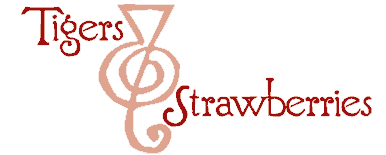
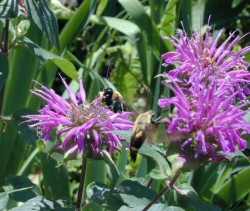
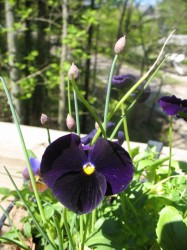
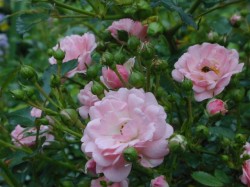
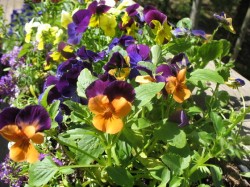
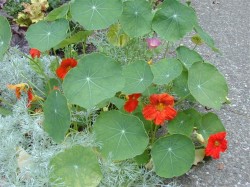
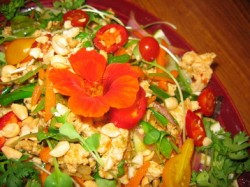


Hi Barbara –
What a great post! I was just eyeing all my nasturtiums this morning thinking that I should start putting them in our salads. I love the peppery flavor. Also, I had no idea you could eat pansies and violas. I have a bunch growing all over both the flower and vegetable garden – can’t believe they’re still alive in our Sacramento heat. Good reminder too about the oleander; I knew they were poisonous but didn’t know they were deadly poisonous. They grow everywhere around here, mostly because they are so drought-tolerant.
Comment by Elise — June 11, 2006 #
Pansies, violas and violets are all edible, Elise, and back in Victorian and Edwardian times, were used often to garnish sweets. In medieval times, violets were used as a flavoring the way roses were, and in France, there are candies still made that are flavored with violets.
Oleander has a compound in it that is similar to that found in digitalis, also known to gardeners as foxglove (another beautiful garden flower that is deadly). It is a cardiac stimulant, so it can, in sufficient doses, or with someone who has heart problems, cause cardiac arrest and death.
With plants like foxglove, oleander, monkshood (aconite)–all with gorgeous flowers, and all deadly poisons–it is no wonder people are wary of eating flowers!
Comment by Barbara — June 11, 2006 #
Savory sells dried lavendar and rose petals (and Moroccan spice blends with those ingredients).
I’ve always wanted to make candied violets, but I haven’t seen any violets since coming to Colorado.
Comment by Mel — June 11, 2006 #
And there’s also borage! We grew that when we had a large garden. It was prolifically self-sowing, so we never had to plant it after the first year… :^)
Comment by Tricia — June 11, 2006 #
About Tricia’s comment–I grew borage specifically to eat it…however the flower seems to have all sorts of unpleasant spiky things on it. Did you cook yours?
Comment by marie — June 11, 2006 #
Aphrodite Cakes, yes! You’re really right, it’s difficult for me to think of flowers to eat.
Comment by tanna — June 11, 2006 #
Marie, we had that garden from 1990-1997, so it’s been a while, but I don’t remember any unpleasant spiky things! I do remember that the leaves were somewhat prickly, but didn’t encounter any problems with the flowers.
This page that describes the borage we grew:
http://www.gardenguides.com/herbs/borage.htm
and here’s a photo with more flowers:
http://home.comcast.net/~mygardensite/borage.jpg
The spiky-looking things in the center – the stamens?? – weren’t at all bothersome when eating them. I remember the blossoms being easy to remove by just plucking them off the sepals. If they didn’t come off readily, I wouldn’t use that one (same deal as picking raspberries).
Comment by Tricia — June 12, 2006 #
I love eating flowers! My husband was a bit suspicious, until he discovered the delights of chive flowers. Now that our chives are established, almost every day we can break a chive flower bundle into individual flowers over a salad, and it give a beautiful purple confetti look, and subtle onion flavor.
Comment by Kim — June 12, 2006 #
Hi Barbara,
Detailed info about edible flowers.
Thank you.
Vineela
Comment by vineela — June 12, 2006 #
Nice post ! First time visitor. While researching on tuberous begonias I read that the flowers are edible.
Comment by Krithika — June 13, 2006 #
Mel–thank you for the source for lavender and rose petals! I have a few rose petals that I dried myself from our garden in Pataskala, but I am quite nearly out of them!
I don’t know that violets grow in Colorado naturally, but I can find you a place to order them, to see if you can grow them if you like. Let me know and I will get you some reputable mail order sources for baby violet plants. (I collect violets and have about five or six different varieties growing currently in the garden. In Pataskala, I had close to a dozen different types.)
Tricia–I love borage, and grew it in my first herb garden, in the last house I lived in with Morganna’s father. I like to think that it self-sowed among the perennial herbs and it all grew wild after I left….
Marie–I only remember borage flowers being kind of hairy, but not too spiky. I wonder if you have a different variety than what I grew?
Kim–chive flowers are great in scrambled eggs, too–you should try them. With a bit of goat cheese, sprinkled in at the last minute. Yum!
Vineela–you are always welcome, you know.
Krithika–thank you for coming by–I hope you keep coming back, and visit me again on the 16th for the round-up for “The Spice is Right III: The Perfumed Garden” where bloggers are pairing edible flowers and spices. It should be fun!
Comment by Barbara — June 13, 2006 #
Oh, and Krithika–tuberous begonia petals have a sort of citrusy taste. Very refreshing and very pretty colors. When I grew them in Pataskala, I used them in salads now and again.
Comment by Barbara — June 13, 2006 #
Uh huh. Yeah, I’ve eaten those. Can’t deal with it though. A salad is tough enough already with all those ‘leafy’ things in there. But flowers too?
Wanna know the funny thing though? I planted a flower garden last weekend all by myself. Vegetables are too finicky to deal with, all that tending. I’ll post pictures as soon as it’s worthy. Rows of sunflowers, tall flower thingies, short ones and wild ones. Even tilled the earth and added fancy healthy dirt.
OH AND GUESS WHAT ??? My barn is getting painted today !!!!!!!!!!! It’s going to be RED with white trim. I can hardly wait, I’m so excited.
Biggles
Comment by Dr. Biggles — June 14, 2006 #
LOL! Biggles, you remind me of my Dad’s face when he looked at the salad I prepared for the housewarming for our first home in Pataskala. It was mixed greens, strawberries, blackberries, chevre, sprouts, nasturtium blossoms and leaves and daylily petals. He made this face, and looked at me and said, “Flowers?! In salad?!” Then, he visibly shuddered and got sliced tomatoes with basil and olive oil instead.
Later, Zak’s Grandfather’s girlfriend shamed him into trying some. He liked it, but he said, “Eating flowers is just weird.”
You planted flowers? Are you going to put pictures on the blog? I love sunflowers, and I really miss my sunflower patch I had in Pataskala. All different shades of yellow, orange and russet. They even come to bicolors! I had great bouquets from that garden….
Fancy healthy dirt helps. Manure is great, too. Composting your kitchen scraps helps a lot too. If you ever grow roses, they like coffee grounds a lot. Just so you know.
Cool on the barn! Better post pictures of that, too!
Comment by Barbara — June 14, 2006 #
Thank you for all the info and recipes!
Comment by Jennifer — September 4, 2006 #
I am trying to find a source in London of violet essence for flavouring fondant. It seems almost impossible; but it must surely be obtainable somewhere. I hope you may be able to give me the needed information. Sincerely, Pierre Wattefr
Comment by Dr. Pierre Watter — September 16, 2006 #
[…] Hardly the shrinking violet type, flirtatious Libra’s cocktail is made with the sweet little Violet, flower child of Venus. Libra and Taurus are both ruled by Venus, as are all things beautiful, sensual, fragrant and sweet. If you’ve ever tasted a violet candy–or a candied violet–you’ll know how delectable this petit fleur can be. My mother’s childhood memories include digging for the violet creme in the box of chocolates her aunt would send every Christmas. That was in Britain where it’s not so hard to secure violet flavoured products; unlike the US, where it’s quite the challenge. You can find Chowards Violet gum & mints at select grocers, but for pretty much anything else Violet we must turn to our faithful World Wide Web companion. Violet syrup, violet liquor, violet candies and crystallized violets can all be found with the click of a mouse. In fact, France even celebrates a Violet Festival (La Fete des Violettes) where the town of Tourrettes sur Loup celebrates the harvesting of these precious blossoms which are it’s livelihood. (Thanks to Little Fancies for this interesting tidbit.) […]
Pingback by Intoxicated Zodiac Blog » Shrinking Voilet - LIBRA COCKTAIL — May 13, 2007 #
I have been collecting my Borage Flowers and they store nicely in the frig. I had not planted Borage in a while… Last year, something voraciously ate at my Spearmint. It looks like the same bug (or catepiller) likes the Borage leaves as well. I can’t find the bugger! Most of the leaves (oh, yes, .. it tasted my Spinach as well), are “edge eaten” which suggests a worm or catepiller; and the small (and getting larger) round bug poopies also suggest a catepiller… But some leaves have bites out the the middle of the leaf. Could it be that sneakly Praying Mantis?
Comment by Darcy — May 31, 2007 #
[…] Tigers & Strawberries ” On Edible Flowers … own, it is very fun and rewarding to explore the myriad scents, colors … we can break a chive flower bundle into individual flowers over a salad, and it … […]
Pingback by sendrewardingflowers.info » Blog Archive — August 21, 2007 #